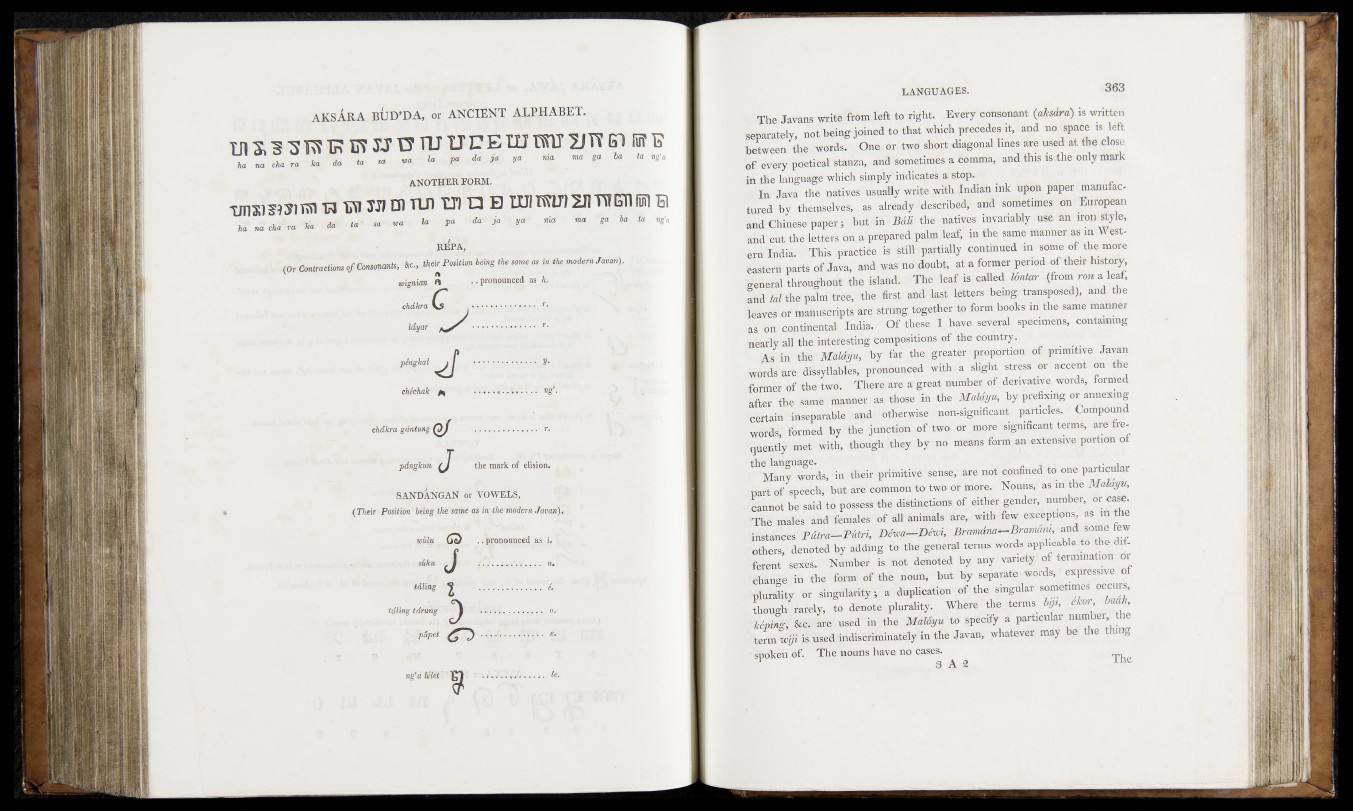
AKSARA BIJD’D A , or ANCIENT ALPHABET.
in s. 3 s w is iff ^ u cE m ^ M^151 m E ha na cha ra ha da la ia.a <° f * * • * . «« * ■ < • 1 f * *
ANOTHER FORM.
tms)5?3irai -a wi rci m tui in a h tuixwisJiTnun m ra
haai-m Ka » »«' »” * *“ ' “ '** ** * **
REPA,
; Gonfraciions of Consonants, &;> * * Positiw S th* sam m i?l 1he Mod*m ''
wignian O . . pronounced as ft.
chakra . • • • • w . t,„
Uyar .................... ’ / ^ ^
pengkal ƒ ............... • • ••.•;;
chichak ^ ftgV • > .
chdkra gdntung (t)J ................... ■*,
pdngkun J the mark of elision. ^
- S'ANDANGAN Sr VoWEllS,
• (Their Position being the same as imthe*jnddern Javanffi
, wiilu 6 a ) . .pronounced as,.if ....
s&ku rtjjp ; .„.rW;... . «.
idling ^ ................. ."T?**/*1”
idlingidrawg .. ' . ' X o, .
.-■^dpe« ............... Vp,;. -|M
LANGUAGES. 303
The Javans write ‘from ïeft tonight; .Every' consonant (aJcsdra) is written
■separately, tiôtbeing j o j n e d « a t which precedes it,' and no space is left
between theWCrds. One; dr two short, diagonal lines are used at the close
of every poet&'abstanza,, ahd Sometimes a comma, andfthis imthe only mark
in the langusige whlEr!®-simply indicates, aJrstop.
In Jav-a- the natives u su a lly -W rite« Indian ink upon p'aper manufac-
tured by themselv.es, as already idescnbèd? and sometimes on European
and- Clïinesë paper • ' but-un 'Bd^ the n a tive invariably Mise an iron-style,
and'cilt-the letters oh a prepared palm l e « the same manner as in West-
ern India’;- ' This praetiëe -is -àtilb partially continued in some Of the more
-eastern parts of Javi* and was no-rUbt, at a former period-of their histbriy
•général throughout the island. The leaf iéM e d lôntàr E g g ron a leaf,
Ihd ^ 't h e h a im ^ 0^--first a n d « 4 e t t e r s ^ i% transposed), and the
^dvéà-:6f1 mànù|ërÿtf'arë,string 'together -to form books lrfthe-same manner
as on^1 continental' India., Of $ese ;I haye^eyéral^specimens, containing
nearly-all%é,interesting compositions of Tthe country. H H H M W i
As in’fthe Malc&u^by far' the greater^ proportion of .primitive Javan
'words- are-: dissyllables, pronounced with a slight .stress’or acçeùt roti ' the
formèr ofthOtwh; ’There, are'^ great number oft'derryative words,: formed
.aW M manner as -those 'in -the Mul&u, byprefixing or annexing
•certain:'inseparable -andd otherwise ■,nonsignificant: particles. » 9 °mP ° J
words, formed'by thê 'junction- of .two .Ot-more ^significant terms, areîfee-
quently ’mèt" tfifh, though « b y mo means form an ^extendive; portion of
-their'p n h ii^ iè n s e , .are not'confined id- one; particular
‘W to f speécK,^ but are'common to two o r « e « o u n s , as m-the MaUyu,
4 n n o t be said to pôsséss the distinction's Of either gender,- member, or case.
The males and females.%ft^l animals are,.with few elections, -as mthe
. %hstan'cèsJ Bdtta—Pûtri, B é ^ D é m Bramdm^Bramârû, g H S |
^Others, ' deribïeëdiy adding to the genëM terms words applicable to the.-drf-
'ifereht géx’e i ’ï^ù'mber is riot denoted by any variety' of termination.:or
rchange ifn [the form of the noun, but 'bÿ separate words,; 1 expressive, of
plurality or singùlârïty ; a dupheation mfHhe‘ °C^
though rarely, to denote plurality.
■ É P W arè used’in-the Malâyü to specify a particular number^the
\e rm ^y 1 iâ- used indiscriminately in tf e Javan,'whatever, may be the. th i^
spoken of. The nouns have no cases. The